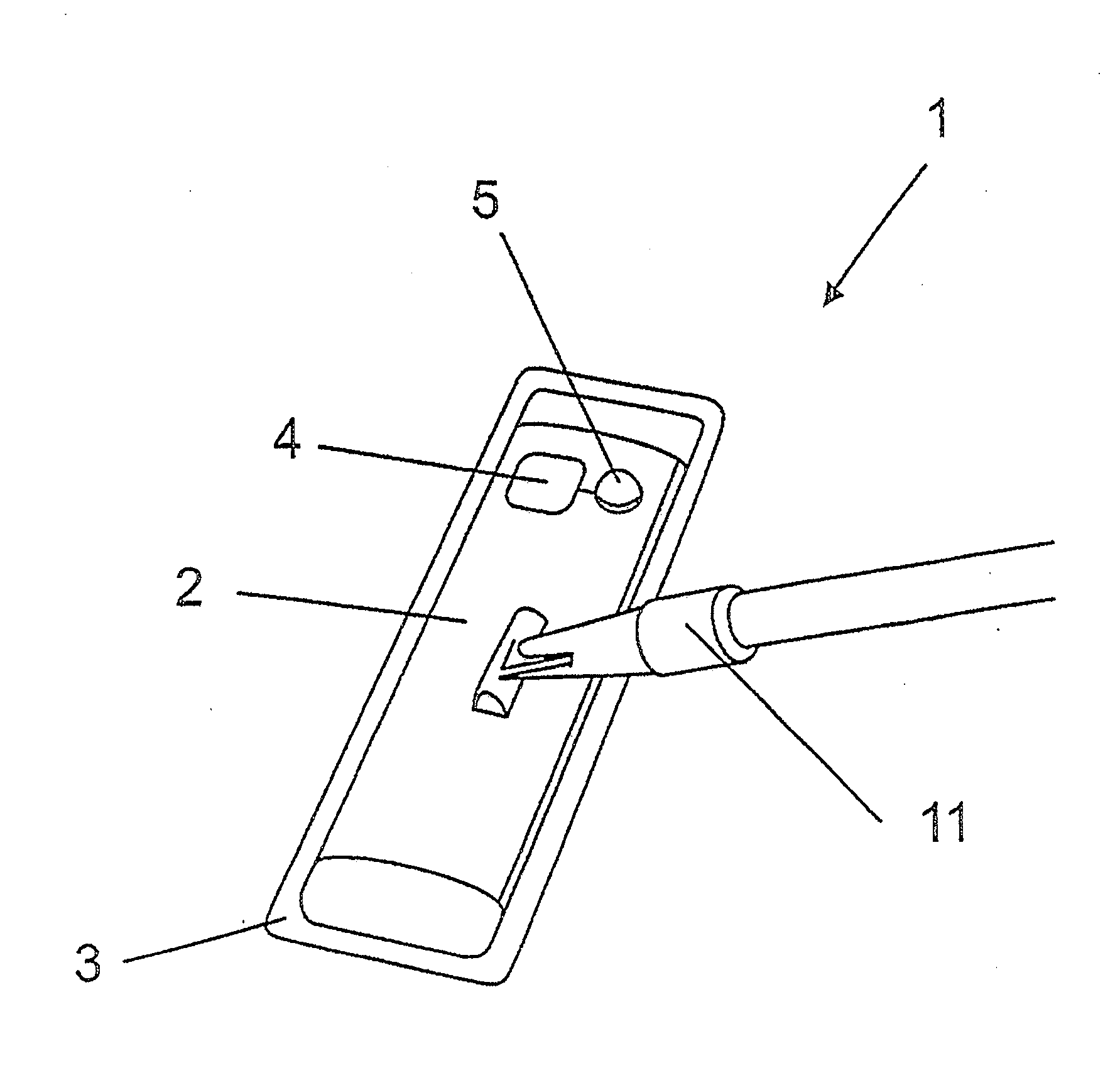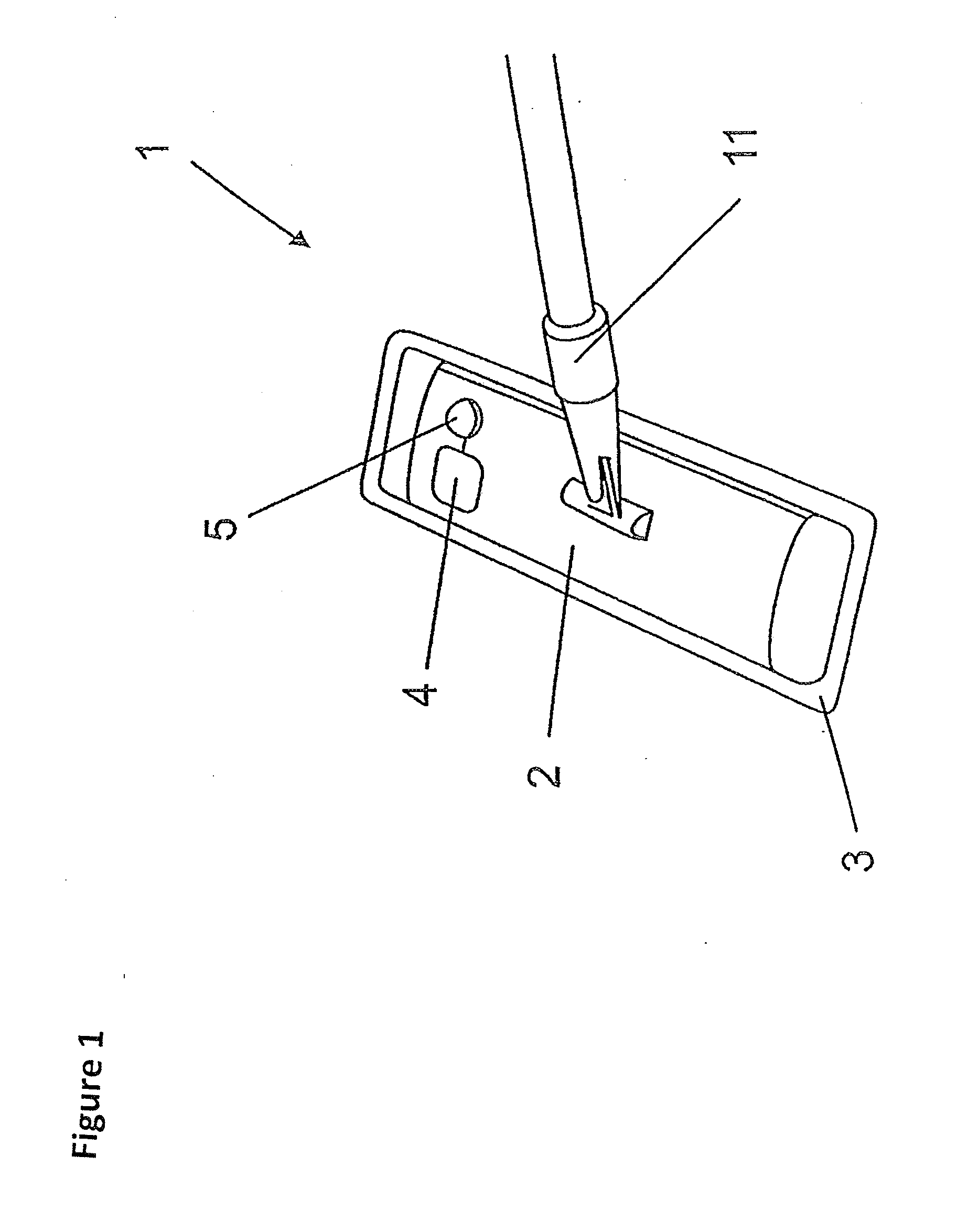[0005]To this end, a measuring device for detecting the
residual moisture present in the mop cover is integrated into the mop plate. Within the course of comprehensive investigations, it became evident that the remaining cleaning performance and the loading of the mop cover with
dirt are directly connected with the
residual moisture of the mop cover. This is particularly true with regard to stubborn and adhering dirt. With a small amount of cleaning liquid, a mop cover also has a certain binding capacity for dust and other loose soilings. However, it has been shown that a sufficient
dissolution capacity, with respect to adhering dirt, results only in a sufficient—that is, a higher—load of cleaning liquid in the mop cover. This means that the cleaning performance declines if there is only a small quantity of cleaning liquid remaining in the mop cover. The less cleaning liquid found in the mop cover, the less dirt which can be bound in the mop cover. In
actual practice, a
visual inspection of the residual
moisture still remaining in the mop cover is often carried out, wherein a criterion for the change of the cover is often the so-called tearing of the
moisture film on the floor. This criterion, however, which is dependent on the type of floor and the light conditions, is an insufficient evaluation. The measuring device, integrated into the mop plate, detects the
moisture formed by the cleaning liquid in the mop cover. It is particularly advantageous hereby that it is not absolutely necessary to modify the mop cover, since the residual moisture can be directly detected by the measuring device. Therefore, any already obtainable mop cover can continue to be used. The measuring device requires energy to a small extent, an energy can be provided by a battery integrated into the measuring device or by a storage battery. When using traditional mop covers, it may be necessary to calibrate the measuring device first. Preferably, the measuring device comprises a device for the averaging of measurement values recorded over a prespecified time period, so that a short interruption of the contact between the mop cover and the mop plate does not lead to a triggering of a
signal.
[0008]The measuring device can determine an electrical parameter of the mop cover. Such measurement variables can be determined in a particularly simple manner, and a large number of measurement methods are known for determining electrical parameters. Moreover, the materials of the mop cover—mostly plastics—basically have electrical parameters different from the cleaning liquid, mostly water with a
cleaning agent and dirt particles, and therefore are good indicators for determining the residual moisture of the mop cover.
[0009]The measuring device can determine the electrical resistance of the mop cover. The electrical resistance of the mop cover is directly dependent on its loading with cleaning liquid. According to one known measurement method, the contact surfaces impinge on the mop cover with less than 50 Hz, using a direct
voltage or a low-frequency alternating
voltage, wherein the electrical resistance of the mop cover behaves in a manner proportional to the measured
electrical current. In another patent method, the electrical conductance of the mop cover can also be determined. The electrical conductance is the reciprocal of the electrical resistance. It can be determined by the impingement of the mop cover with a higher-frequency electrical alternating
voltage of more than 50 Hz. Both measurement methods are relatively simple.
[0010]The
measurement device can also determine the
permittivity of the mop cover. The
permittivity, the
capacity value, is a measurement of the permeability of a material for electrical fields. For example,
polypropylene, a material frequently used for mop covers, has a
permittivity of approximately 2 and water has a permittivity of 80. A
high loading of the mop cover with water accordingly results in a higher permittivity than an unloaded mop cover. Other contact surfaces can be integrated in the mop cover. The other contact surfaces are preferably operatively connected, in an
electrically conductive manner, with the contact surfaces of the mop plate and thus improve the measurement result and the measurement accuracy.
[0011]The mop cover can be provided with
metal wires or
electrically conductive threads. They are preferably arranged parallel to one another. The
metal wires or the threads also improve the measurement result, since they are at a defined distance from one another and thus provide measurement results, comparable to one another. To this end, the
metal wires are preferably connected with the other contact surfaces. It is also conceivable that the metal wires are in direct contact with the contact surfaces of the mop plate or that the metal wires or the threads have extended areas, which form additional contact surfaces.
Metal wires or threads are particularly low-cost and simple to process. However, the binding in of conductive structures instead of metal wires is also conceivable. Such structures can, for example, be
electrically conductive carbon-containing threads.
[0013]A method is also provided for monitoring the cleaning performance of a mop cover affixed to a mop plate of a mopping device in which the quantity of cleaning liquid present in the mop cover is detected by a measuring device integrated into the mop plate. A
signal is triggered if a prespecified threshold value of the quantity of cleaning liquid is not reached or is exceeded. An indication that a threshold has been exceeded prevents the overloading of the mop cover with cleaning liquid during the rinsing and the subsequent wringing or during the preliminary moistening or impregnating of the mop cover.
 Login to View More
Login to View More 


